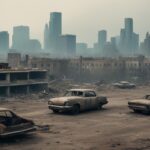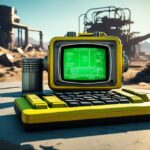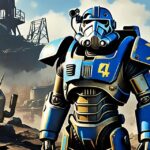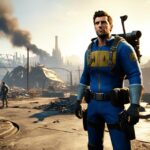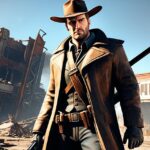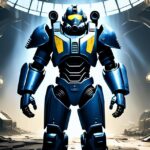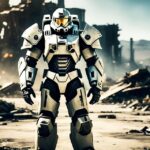Table of Contents
Fallout 4 by Bethesda is a game many waited for in the post-apocalyptic world. Its concept art gives us a striking preview of the Commonwealth. This is a place new to the series. However, the game itself was lacking in key areas. Fans noted the absence of a RPG system and found the landscapes uninspired.
The Art of Fallout 4 book revealed concept artwork way ahead of the game’s graphics. We will dive into the differences between the early art and final game. This will include a look at the technological limits that played a role.
Let’s explore the artistic journey of Fallout 4 together. We’ll discover the hidden details of the captivating concept art.
A Misleading Commonwealth Battle
Fallout 4, a game loved by many, was set to be truly engaging through its art. The Commonwealth was meant to be grand. Unfortunately, the game didn’t fully meet the high expectations set by its artwork. The depiction of Commonwealth and its battles was a real letdown for players.
The art showed our character fighting atop a flying Vertibird with a minigun. It made fans dream of heroic battles. But, in the real game, this experience was quite lacking.
The promised huge battle felt small and unimportant. Players hoped for more depth in the fight. They were left wanting the excitement that the art suggested.
The concept art showcased a Commonwealth battle imbued with chaos and excitement, yet the final game presented a more restrained and lackluster affair.
Fallout 4 included groups like the Brotherhood of Steel, adding to the air with their giant airship, the Prydwen. The helicopters, part of the Brotherhood’s strength, were key symbols. However, there wasn’t much to do with these groups. Thus, the game’s narrative on the Commonwealth battle fell short of players’ expectations.
The Disparity Between Vision and Reality
The gap between the concept art and the game itself highlights a key issue. Translating grand ideas into the game’s experience is tough. The game’s development limits and graphics can hold back the final outcome.
Still, we must value the art’s hard work and creative ideas. It was pure inspiration for the game’s fans. The effort from the artists is clear and should be recognised.
| Concept Art | Final Game | |
|---|---|---|
| Player Experience | Immersive and dynamic | Repetitive and limited |
| Interactions with Factions | Multiple meaningful options | Restricted and inconsequential |
| Consequences | Significant impact on the narrative | Minimal and superficial |
The concept art for the Commonwealth battle in Fallout 4 set high hopes. The game didn’t fully match these expectations. Yet, it’s vital to see the effort in the game’s design and art. Lessons from this can help make future games better.
Lost Light Of The Commonwealth
In Fallout 4, the Institute is a place full of secrets. It’s in the old M.I.T. Ruins. The idea for the Institute was to show it as all bright and clean, much different from the final game’s dark and eerie look. This change gave it a more mysterious and spooky feel, like a hospital.
The dark setting in the game was a big switch from the beautiful images in its concept art. This dark design was intentional. It aimed to make the place feel more hidden and alone. This way, the game felt more real when players explored the old M.I.T. Ruins.
While fans might have hoped for more from the concept art, there were many hurdles to face in making the game. Turning a creative vision into a playable world is tough. The game had to balance its look with how well it played, which meant some details were changed.
Exploring The Dark Corridors
The dark twists and turns of the Institute added a lot of tension to Fallout 4. As players walk through it, they’re on edge, never sure what they’ll find next. The lack of light hints at the strange experiments and studies happening inside, making it a chilling place.
“The dark corridors of the Institute truly immerse players in its clandestine world, where every step is filled with anticipation and dread.”
The Institute’s dark design isn’t just for looks. It makes players think about the Institute’s true character. By having lots of shadows, the game hints that there’s more to this place than meets the eye. Players get to think about what’s right and wrong as they journey through the Institute.
An Enigmatic Faction’s Setting
The darkness and shadow in the Institute show a big difference between its science and its ethics. This makes for a very interesting space in the game. The contrast between the bright concept art and the dark reality makes the Institute more alluring and mysterious.
| Pros | Cons |
|---|---|
| The dark corridors reinforce the secretive nature of the Institute | Deviation from the visually stunning concept art |
| Adds tension and suspense to gameplay | Limited visibility within the Institute |
| Reflects the moral ambiguity of the faction | May disappoint fans expecting a brighter environment |
Even though what the game showed was different from what was first imagined, the Institute is still a very important part of the game. The dim corridors and the lack of light make it very intriguing. It draws players into the secrets of Fallout 4’s Commonwealth.
An Unusually Barren Cul-De-Sac
The concept of Fallout 4 Sanctuary Hills changes a lot between the first idea and the final game. The initial art shows a ruined place from the war. It has ruined homes and more destruction than the game itself. Many homes in Sanctuary Hills look okay even after 200 years in the game. This could be because of graphical limits or a choice to make it nicer to look at.
Even though the game’s look is different, the early art for Sanctuary Hills is quite striking. It shows homes that are messed up and falling apart. This makes you feel sad and alone, fitting perfectly into the Fallout world. The art really focuses on the small details and how the light and shadows play, stirring up feelings of sorrow and remembering better times.
In the words of Bethesda’s artists, “We wanted to show the true aftermath of the Great War, with a Sanctuary Hills that reflected the devastation and tragedy. When developing the final game, however, we had to take into consideration the graphical limitations and ensure that the settlement remained visually compelling for players.”
The choice to keep Sanctuary Hills looking better in the game was tough. It was about balancing how it looks with how players would feel. They aimed to keep its role as a safe place in a messed-up world. This change makes the game more enjoyable, sticking to the main idea of Fallout 4.
Even with these changes, the initial art of Sanctuary Hills shows the effort put into Fallout 4. It proves how talented the artists are, creating a world destroyed by nuclear war. We get a peek at their creativity and hard work, adding to the game’s deep story.
Mirrors Are His Worst Enemy
In Fallout 4, Hancock’s character design is striking. The concept art shows him with hooped earrings and blonde hair. Yet, his final look in the game is mostly known for his deep black eyes.
The early art was more daring, but Hancock’s true self still comes through in the game. This is thanks to excellent writing and voice work. They give life to this complex character.
Concept art is a designer’s first step in bringing a character to life. It lets them try new ideas and visions. For Hancock, it showed a bold and unique style that reflects his rebellious spirit.
“Concept art is a crucial part of the creative process, providing a glimpse into the early stages of character design. It allows artists to experiment and push boundaries, ultimately shaping the final appearance of beloved characters like Hancock.” – Art Director, Bethesda Studios
The in-game version might be different from the art. This is often because of technical limitations. But, Hancock is still a memorable character. Players love him for his story and unique dialogue.
Character Design in Fallout 4
In Fallout 4, character design sets the scene for players. Every character’s look tells a story. It shows where they come from and what they’ve been through.
From the Vault Dwellers to faction leaders, each design is important. It makes the game’s world feel real. Players develop strong attachments to these characters.
- Fallout 4 captures the essence of the post-apocalyptic world through its character design.
- The characters’ appearances reflect their journeys and experiences within the game.
- From ghouls to super mutants, each character has a unique visual identity that adds to the overall narrative.
In Fallout 4, character design does more than please the eye. It tells deep stories and adds to the game’s lore. Players connect with the characters emotionally. Whether a ghoul or companion, they all stand out.
In the end, Hancock’s concept art may have been different from his final look. But, the character’s true nature shines through. This is due to the game’s well-crafted narrative. Character design in Fallout 4 is key to its success. It brings the game’s world and characters to life.
Unveiling the Artistic Journey of Fallout 4 Concept Art
The concept art of Fallout 4 gives us a look at the game’s creative design. Made by Bethesda, this artwork captivates fans with its imaginative worlds. Even though the final game looks different from this early art, it shows Bethesda’s drive to make their worlds rich and detailed.
This artwork is filled with lush scenes and details of the game’s groups. It makes players eager to dive into a well-crafted world. The real game might not match every detail, but the art gives us a peek into what the creators wanted to achieve.
Even if changes had to be made due to technical limits, Fallout 4’s concept art remains inspiring. It shows how much can be done with creativity and visuals. When exploring the game’s world, players can sense the effort put into every corner.
In the end, Fallout 4’s concept art is more than just pictures. It reflects Bethesda’s quest for excellence and immersion. The art sparks our thoughts, showing us the grand creative plan of the game.
FAQ
What is Fallout 4 concept art?
It’s the creative visual work made while Fallout 4 was being developed. It shows the unique designs of the Commonwealth and its groups.
Who developed Fallout 4?
Bethesda Game Studios brought Fallout 4 to life.
Why were fans disappointed with the final game?
Fans wished for a deeper role-playing system. They also found the game’s landscapes not very exciting.
How does the concept art differ from the final game’s depiction of the Commonwealth battle?
The art shows the player shooting a minigun from a Vertibird in an exciting moment.
However, in the game, this action is limited and lacks meaningful outcomes for different factions you can join.
What is the difference between the concept art and the final game’s depiction of the Institute?
The art portrays the Institute as a pure group, with bright and clean rooms.
In contrast, the game shows it as a gloomy place with dimly lit areas, making it feel like a dark hospital.
How does the concept art of Sanctuary Hills differ from its depiction in the final game?
It shows the place with a lot of destruction and ruined houses in the art.
Yet, in the game, many homes look almost untouched after 200 years since the Great War.
What is the difference in character design for Hancock between the concept art and the game?
The art gives Hancock a lively look with unique earrings and blonde hair on his old face.
In the game, his design is simpler, but his all-black eyes stand out.
What does Fallout 4 concept art offer despite the differences with the final game?
It attracts fans, showing them the creative world of the Commonwealth and its groups. It highlights Bethesda’s hard work in making detailed and beautiful settings.
Source Links
- https://www.thegamer.com/lowered-expectations-fallout-4-concept-artworks-make-game-disappointing/
- https://soulstuck.tumblr.com/post/147418096559/fallout-4-far-harbor-concept-art-shared-via
- https://www.linkedin.com/posts/ricardopadilla01_conceptart-environmentart-gameart-activity-6810087768035860480-w3kD


